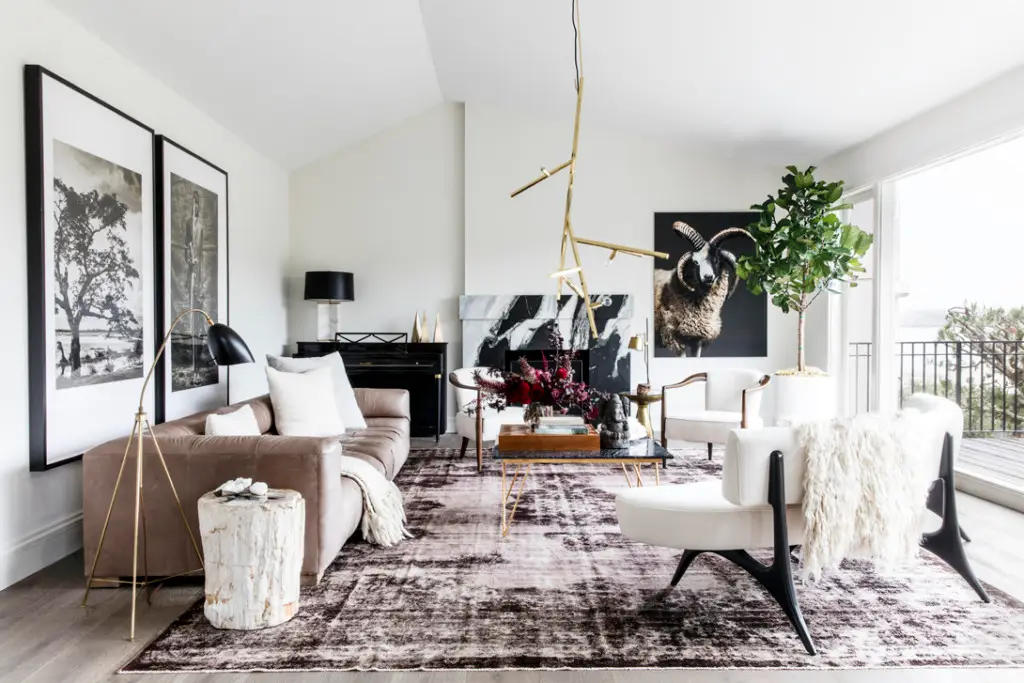Interior designers Jeff and Tray Schlarb mix shapes, colors and textures in their midcentury sea cliff home.
TWO YEARS AGO, when Jeff Schlarb, 41, and his wife, Tray, found a triangular site with an unimpressive 1955 two-story split-level house in San Francisco’s Sea Cliff neighborhood, they snapped it up.
“We’ve always liked odd lots,” Schlarb says. The L-shaped 2,500-square-foot structure, atop a garage and basement rooms on a slightly sloped lot, was nothing like its 1930s neoclassical neighbors. Although it needed a lot of tweaking, “we loved its midcentury simplicity,” he recalls.
“Sea Cliff is truly inspirational,” Schlarb says. “It is like no other neighborhood. We are not actually on a cliff, but we hear waves and smell the ocean.”
Just four houses away, a hidden path used by families, kids, dogs and bicyclists leads to the beach. “There is a community of neat people who like walking rather than driving. We fell in love with all that and knew we could create something cool,” he says.
Since moving to San Francisco in 2001 from London, where they first met, the couple has remodeled at least five homes with their collective expertise: she is a trained interior designer from South Africa and he studied business in Missouri and European history in Belgium. They simultaneously launched Green Couch, a home-staging company.
Unexpectedly, Schlarb found himself making design decisions as well, and that eventually led to the start of Jeff Schlarb Designs.
“I don’t quite know how I ended up doing interior design but I fell in love with it,” he says. “The work found me!”
So the busy pair enthusiastically tackled the design of this latest project with Schlarb at the helm.
The interior now has 3,400 square feet of usable space on three levels.
With architect Ryan Knock, the Schlarbs made several strategic floor plan changes to the kitchen, dining and living rooms to create a new powder room off the kitchen and, half a story below, next to the two bedrooms for their daughters Isabella, 9, and Audrey, 6, an extra office space/den for Schlarb.
The L-shaped living/dining room on the top floor seems larger because a wall between the kitchen and dining area is now gone, making for a truly open plan. True, adding a 4-footwide wall for the powder room did wind up obstructing a preexisting Golden Gate Bridge view from the front door. But now, “that change forces you to fully enter the living space before you see the view,” Schlarb says approvingly. “When you see it from the middle of the room, the bridge is perfectly framed by the windows.”
They also pushed false ceilings up to the roofline wherever possible. But in the living room Schlarb decided to set the apex of the peaked ceiling off-center and not directly above the central chimney for the fireplace against the west wall. “We did not want it to look like the inside of a barn,” he explains.
A marble-wrapped kitchen island with a long cantilevered top is a sculptural addition he particularly loves: “It looks so simple but was very hard to achieve, with a lot of structural steel hidden within it.”
The old split-level basement used to have two jerry-rigged bedrooms and a family room, as well as very low ceilings. They lowered the entire floor into the crawl space below, and now a small guest bathroom, a guest room, a family room, and a master suite with a capacious bathroom are all on the same level, with 9-foot-high ceilings.
New French doors in the master bedroom open to a small deck “where we have coffee and tea in the morning and smell the sea and listen to waves crashing on the beach,” Schlarb says.
While husband and wife were completely in sync regarding the architectural moves, they sparred when it came to the design of the interiors.
“Tray likes tone on tone and prefers cream and beige, but I like contrast, colors, shapes and textures,” he says.
Thus, gray Touraine-engineered oak planks by DuChateau cover the floors, and walls are painted subtle variations of white from room to room — but with a couple of notable exceptions. Schlarb exercised less restraint in the powder room, which has jazzy Timorous Beasties ombre wallpaper, and in his den, which also has a sloped ceiling, the walls are painted a deep navy blue.
“If every room were a showstopper like this one, it would have been too much,” he admits with a laugh. “I don’t like to give people a headache.”
Still, his shoot-from-the-hip eclecticism is visible throughout.
Framed animal images, sculptural light fixtures and modern chandeliers confirm that the maverick designer’s do’s and don’ts aren’t from any rule book.
“In boxy spaces or in a corner I use a barrel-back chair so it does not compete with the walls,” Schlarb says. “I look for a handsome shape. If I’ve seen it too much, I avoid it because I don’t want something trendy.”
“When you mix art with engaging, artful furnishings there is something to look at. You can stop and admire a painting or pause at a handmade object and wonder if it was sewn or glued together, if its material is acrylic or leather,” he says.
Eschewing midcentury furniture clichés, he opted instead for the curves and angles of a classic Holly Hunt chair and a tufted sofa in the living room; a custom settee was inspired by a vintage Vladimir Kagan original; a hard-to-find ovoid dining table is from HD Buttercup.
And on the wall he hung Meghan Bogden Shimek’s blue braided fiber art, because “I just needed the wild color!”

